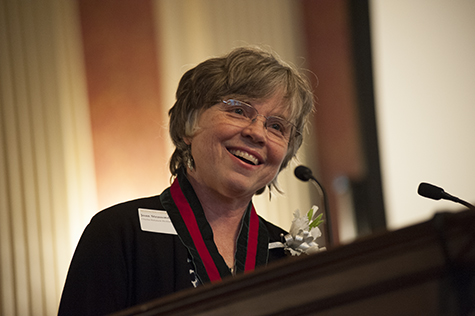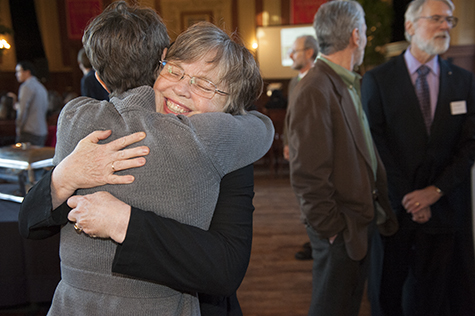
Biologist Joan E. Strassmann was installed Jan. 23 as the Charles Rebstock Professor of Biology in Arts & Sciences in a ceremony in Holmes Lounge, Ridgley Hall.
“An endowed professorship is the highest-level appointment that we can make, and Professor Strassmann joins a very distinguished group of fellow chair holders who have made a big difference in the life of this community,” Washington University in St. Louis Chancellor Mark S. Wrighton said.
The Rebstock professorship was established in 1925 with a bequest from Charles Rebstock, a distiller who became a philanthropist on the eve of Prohibition in 1920 and whose generosity also made possible the construction of Rebstock Hall for biology and botany. The professorship was previously held by Alan Templeton, PhD, who became emeritus last year. Strassmann was Templeton’s first PhD student.
Strassmann was introduced by Barbara A. Schaal, dean of the Faculty of Arts & Sciences and the Mary-Dell Chilton Distinguished Professor. Strassmann earned a bachelor’s degree in zoology from the University of Michigan and a PhD, also in zoology, from the University of Texas at Austin. Her dissertation explored theories of social behavior and evolution using individually marked social wasps in wild colonies, Schaal said.
In 1980, she joined the faculty at Rice University, eventually becoming department chair and the Harry C. and Olga K. Wiess Professor in Natural Sciences in the Department of Ecology and Evolutionary Biology.
A few years after joining the Rice faculty, she met her husband and collaborator, Spencer T. Olin Professor of Biology David C. Queller. Strassmann and Queller collaborated on many studies of social insects at field sites in Venezuela, Brazil and Italy. In the summer of 2011, they joined the biology department of Washington University in St. Louis, where they continue to explore social evolution.

Following the formal installation, Strassmann gave an entertaining talk about a high-stakes gamble she and Queller made 15 years ago: to switch from studying cooperation and conflict in social insects, famous for their complex societal arrangements, to studying it in an amoeba, whose claim to fame had been its simple lifestyle.
“We spent a quarter-century studying the social behavior of wasps in places such as the olive groves of Tuscany and the rain forests of Venezuela,” Strassmann said. “Why, having become experts in the habits and habitats of wasps, did we decide to switch to social amoebas, a group of organisms we knew little about? “
“Not only did the organisms belong to different kingdoms,” she said, “we also had to learn new techniques to study them, establish new networks of colleagues and even join different science societies.
“The lure,” said Strassmann, “was a chance to remedy a major deficit in the study of social behavior. We had originally been inspired by the work of English evolutionary biologist William D. Hamilton, who had argued that altruistic behavior could evolve if the genes responsible for the behavior benefited kin that shared copies of the same genes. But this account of altruism,” she continued, “had been pursued largely without knowing anything about the actual genes that underlie social behavior.”
Others, such as Princeton biologist John Tyler Bonner, had pointed out that Dictyostelium discoideum might make a good organism for studying cooperation because the amoebas live both singly and, when food is scarce, collectively, forming slugs and fruiting bodies made up of many amoeba acting as one. What’s more, Dicty had been sequenced, and scientists using it to study development had developed a superb toolkit for manipulating its DNA.
But if they were to make the transition, they would have to learn how to make Dicty thrive in their lab. “We found a friendly community at dictyBase, a database and listserv whose members would answer all kinds of questions,” Strassmann said. “But while we struggled to become good microbiologists, we spent two years studying what amounted to the biology of dying cells.” She compared the experience to losing your raft as you approach Class IV whitewater.
At a crucial moment, however, they got an offer and a push. Dennis Walker, of Utah State University, whom they never had met, offered them a genetically diverse collection of wild-caught clones. “Such a collection might not seem special,” Strassmann said, “but molecular biologists almost always worked with the descendants of a single clone, which has been bred to behave well in the laboratory. To us, a single clone was of little use, because one would expect the cells in a clone to behave cooperatively, for the same reasons the cells in the human body do.
“I declined the clones, because I was worried we wouldn’t know what to do with them. But then, Walker said he was headed to Australia, so we said ‘OK, send them on over.’ And he did.”
They published their first paper on Dictyostelium discoideum in Nature in 2000. It described the crucial finding that meant Dicty would in fact work as a model for social evolution. When the cells of two clones were mixed together, fruiting bodies included cells from both clones, and, in some cases, one of the clones cheated by contributing disproportionately to the fruiting body.
The mixing and cheating confirmed that the aggregate is a complex social system that can be used to study conflict and cooperation. Ever since then, they’ve been racing to answer the questions that keep tumbling out of each new experiment they design to answer a prior question.
What kept them going when all those amoeba were dying in the lab?
“We were really interested in the questions we were asking,” Strassmann said. “We had students who were also really interested in the questions. We had great mentors, such as Rich Kessin of Columbia University, who would sketch out elaborate plans and answer the phone at all hours and help us out. And we had great collaborators, including Adam Kuspa and Gadi Shaulsky, at Baylor College of Medicine, with whom we wrote our first really big Dicty grant.”
In the end, collaboration with others allowed them to do what they could not have done alone. Strassmann compared the strength of the scientists acting together to an arch, which can frame a much larger opening than a single-stone lintel. “The scientific community as a whole can make glorious things with arches,” she said, “such as the aqueduct in Segovia.”
“Our switch from wasps to social amoeba paralleled, in a curious way, the behavior of the amoebas themselves,” Strassmann said. “We were accustomed to picking our research questions independently in the mode of field biology, but to get to greener research pastures, we had to work more cooperatively with the larger Dictyostelium community.”